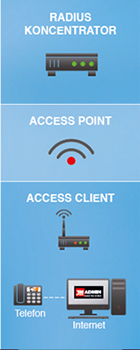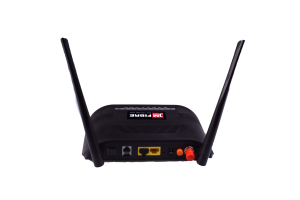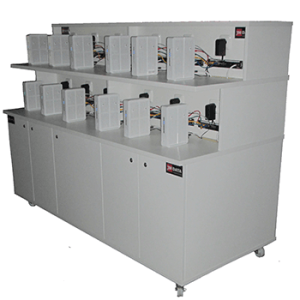JM-DATA: WiFi solution


JM-DATA has a complete WiFi solution.
You can manage your wireless clients via Radius (PPOE, PPTP). So each client have a Wi-Fi Access-Client and can connect to the Access-Point. Over the Radius Protocol we manage, speed, traffic volume and Online/Offline Status.
The Software is JM-DATA ADMIN.
Of course, monitoring is also included, which monitors the links and also issues alarm messages.
Our solution is completely manufacturer-independent and so you can continue to use or use all common WiFi hardware devices (Mikrotik, Juniper, Cisco, UNIFI, TRENDnet, …).
What does WiFi mean?
WiFi is not an acronym; it is a brand name created by a marketing firm that’s meant to serve as an interoperability seal for marketing efforts.
How does WiFi work?
On the technical side, the IEEE 802.11 standard defines the protocols that enable communications with current WiFi-enabled wireless devices, including wireless routers and wireless access points. Wireless access points support different IEEE standards.
Each standard is an amendment that was ratified over time. The standards operate on varying frequencies, deliver different bandwidth, and support different numbers of channels.
What is a wireless access point?
A wireless access point (AP) allows wireless devices to connect to the wireless network. Having a JM-DATA wireless network makes it easy to bring new devices online and provides flexible support to mobile workers.
What a wireless access point does for your network is similar to what an amplifier does for your home stereo. An access point takes the bandwidth coming from a router and stretches it so that many devices can go on the network from farther distances away. But a wireless access point does more than simply extend WiFi. It can also give useful data about the devices on the network, provide proactive security, and serve many other practical purposes.
What is a wireless router?
Wireless routers are commonly found in homes. They’re the hardware devices that Internet service providers use to connect you to their cable or xDSL Internet network.
A wireless router is sometimes referred to as a wireless local area network (WLAN) device. A wireless network is also called a WiFi network.
A wireless router combines the networking functions of a wireless access point and a router. Read more about wireless routers.
What is a desktop WiFi router?
The most common way for users to connect to the Internet wirelessly is with a desktop wireless (WiFi) router. These routers look like small boxes with multiple short antennas to help broadcast the signal throughout a home or workplace. The farther a user is from the base WiFi router, the weaker the signal. So multiple wireless routers, called range extenders, usually are placed throughout the workspace. WiFi range extenders, placed in an array, boost or extend Internet coverage.
What is a mobile hotspot?
A mobile hotspot is a common feature on smartphones with both tethered and untethered connections. When you turn on your phone’s mobile hotspot, you share your wireless network connection with other devices that can then access the Internet.
What is portable WiFi hotspot?
A portable WiFi hotspot is a mobile hotspot obtained through a cell phone carrier. It’s a small device that uses cellular towers that broadcast high-speed 3G or 4G broadband signals. Multiple devices, like iPads and laptops, can then connect wirelessly to the device, which in turn seamlessly connects to the Internet where ever you travel. Similar to a cell phone, the portable hotspot’s monthly cost is based on the data usage plan you select. A portable WiFi hotspot is a more reliable way to access the Internet than searching for static public WiFi hotspots.



